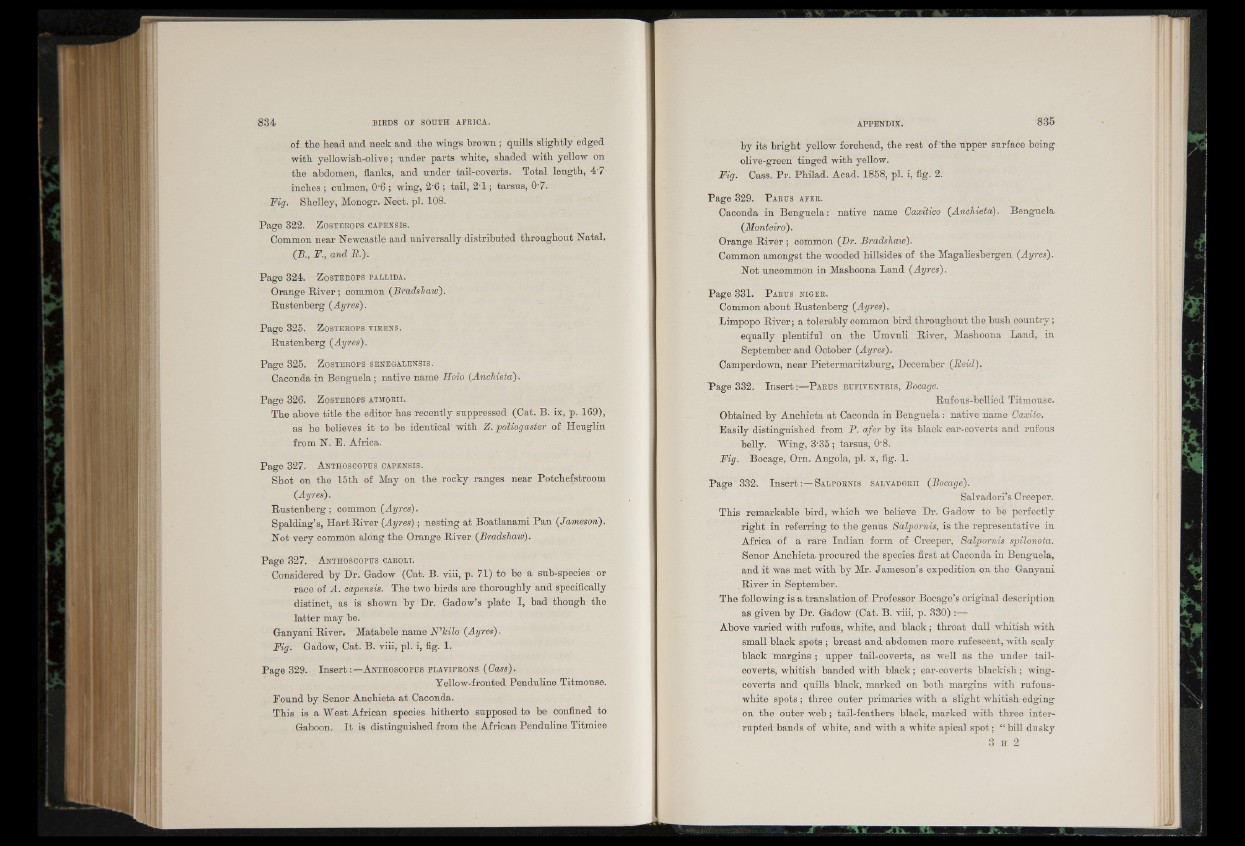
of the head and neck and the wings brown ; quills slightly edged
with yellowish-olive; under parts white, shaded with yellow on
the abdomen, flanks, and under tail-coverts. Total length, 4'7
inches ; culmen, 0'6 ; wing, 2'6 ; tail, 2 T ; tarsus, 0‘7.
Fig. Shelley, Monogr. Nect. pi. 108.
Page 322. Z o s t e r o p s c a p e n s is .
Common near Newcastle and universally distributed throughout Natal.
(P., F., and it.).
Page 324. Z o s t e r o p s p a ll id a .
Orange River; common (Bradshaw).
Rustenberg (Ayres).
Page 325. Z o s t e r o p s v i r e k s .
Rustenberg (Ayres).
Page 325. Z o s t e r o p s s e n e g a l e n s is .
Caconda in Benguela; native name Hoio (Anchieta).
Page 326. Z o s t e r o p s a tm o r ii.
The above title the editor has recently suppressed (Cat. B. ix, p. 169),
as he believes it to be identical with Z. poliogaster of Heuglin
from N. E. Africa.
Page 327. A n th o s c o p u s c a p e n s is .
Shot on the 15th of May on the rocky ranges near Potchefstroom
(Ayres).
Rustenberg; common (Ayres).
Spalding’s, H a rt River (Ayres); nesting at Boatlanami Pan (Jameson).
Not very common along the Orange River (Bradshaw).
Page 327. A n th o s c o p u s c a r o l t .
Considered by Dr. Gadow (Cat. B. viii, p. 71) to be a sub-species or
race of A. capensis. The two birds are thoroughly and specifically
distinct, as is shown by Dr. Gadow’s plate I, bad though the
latter may be.
Ganyani River. Matabele name N ’Jcilo (Ayres).
Fig. Gadow, Cat. B. viii, pi. i, fig. 1.
Page 329. In s e r t:—A n th o s c o p u s f l a v i f r o n s (Gass).
Yellow-fronted Penduline Titmouse.
Found by Senor Anchieta a t Caconda.
This is a West African species hitherto supposed to be confined to
Gaboon. I t is distinguished from the African Penduline Titmice
by its bright yellow forehead, the rest of the upper surface being
olive-green tinged with yellow.
Fig. Cass. Pr. Philad. Acad. 1858, pi. i, fig. 2.
Page 329. P a r u s a f e r .
Caconda in Benguela: native name Gaxiiico (Anchieta). Benguela
(Monteiro).
Orange River ; common (Dr. Bradshaw).
Common amongst the wooded hillsides of the Magaliesbergen (Ayres).
Not uncommon in Mashoona Land (Ayres).
Page 331. P a r u s n ig e r .
Common about Rustenberg (Ayres).
Limpopo River; a tolerably common bird throughout the bush country;
equally plentiful on the Umvuli River, Mashoona Land, in
September and October (Ayres).
Camperdown, near Pietermaritzburg, December (Reid).
Page 332. In s e rt:—P a r u s r u f i v e n t r i s , Bocage.R
ufous-bellied Titmouse.
Obtained by Anchieta at Caconda in Benguela : native name Caxito.
Easily distinguished from P. afer by its black ear-coverts and rufous
belly. Wing, 3'35 ; tarsus, 0'8.
Fig. Bocage, Orn. Angola, pi. x, fig. 1.
Page 332. In se rt:—S a lp o r n is s a lv a d o r i i (Bocage).
Salvadori’s Creeper.
This remarkable bird, which we believe Dr. Gadow to be perfectly
right in referring to the genus Salpornis, is the representative in
Africa of a rare Indian form of Creeper, Salpornis spilonota.
Senor Anchieta procured the species first a t Caconda in Benguela,
and it was met with by Mr. Jameson’s expedition on the Ganyani
River in September.
The following is a translation of Professor Bocage’s original description
as given by Dr. Gadow (Cat. B. viii, p. 330) :—-
Above varied with rufous, white, and black; throat dull whitish with
small black spots ; breast and abdomen more rufescent, with scaly
black margins ; upper tail-coverts, as well as the under tail-
coverts, whitish banded with black; ear-coverts blackish ; wing-
coverts and quills black, marked on both margins with rufous-
white spots; three outer primaries with a slight whitish edging
on the outer w eb ; tail-feathers black, marked with three interrupted
bands of white, and with a white apical spot; “ bill dusky
3 H 2